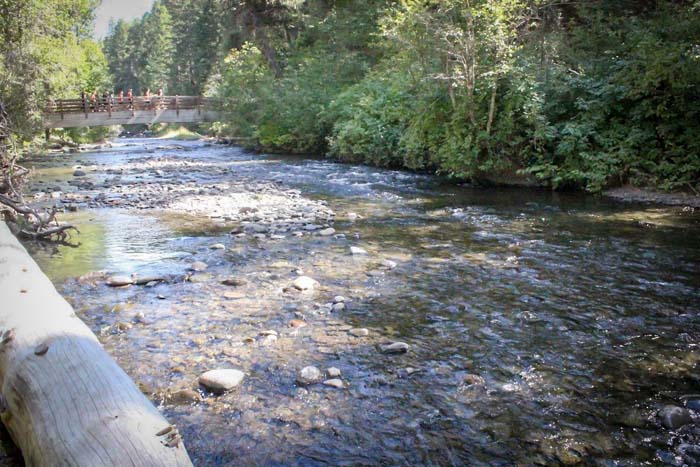Upland pursuits: Traditional techniques to trick trout in a mountain meadow
Published 3:00 am Saturday, July 15, 2023

- Trumbo
It was late afternoon when I finally made camp. Fortunately, daylight lingers well past 9 o’clock in the Pacific time zone in late June, leaving ample time to get eyes on the high mountain meadow that I had come to experience.
Trending
Breaking out of the evergreens and into the meadow left me confused. Aerial imagery showed a stream meandering magnificently through the lush vegetation; however, there was no sign of a creek, only grasses waving in the evening breeze.
“I’ll take a stroll and see what I can see,” I thought, completely prepared to find a dry ditch or nothing at all.
Surprisingly, as I neared the edge of the meadow where the grasses gave way to timber and rising topography, a crack narrow enough to step across became visible about 15 feet ahead.
Trending
“No way does this thing hold trout,” I thought as I studied the dribble of water zigzagging its way down the meadow. “Well, only one way to find out.”
I stick to classic patterns when approaching new trout water, and this time I reached for a size 14 parachute March brown. And, while my first impression left extreme skepticism, the instantaneous trounce of a feisty brook trout proved my pessimism dead wrong.
The fish was small, around 6 inches long, but it boasted a fiery orange belly, olive dorsal, and rosy speckles surrounded by a sky-blue halo – the masterpiece that is a wild, high-mountain brook trout. Its colors popped vibrantly in the glow of the evening sun above a carpet of canary yellow buttercups. It was the first of many brookies and rainbows to come; the largest was about 10 inches long and a true trophy for such a tiny creek. A standard western fly rod and dry flies caught fish, but over several days I honed my techniques to perfection with a mix of Western and tenkara fly-fishing methods.
Tenkara fishing is a traditional Japanese method developed hundreds of years ago on mountain trout streams. The Japanese method parallels our Western fly-fishing method in the types of baits and presentations used, but live baits like crickets were used rather than artificial flies.
The traditional tenkara rod was a long, flexible bamboo cane with a fixed length of line made from natural material like hemp. The long, lightweight rod provided for easy bait presentation and quick capture of the small mountain fish. Tenkara fishing remained predominantly in Japan until 2009 when Daniel Galhardo founded Tenkara USA and introduced this simplistic and highly effective method to America. While modern tenkara fishing still consists of the basics – rod, line, and fly – telescopic carbon fiber rods and a variety of lines and artificial flies offer tremendous flexibility for a wide variety of situations.
That first evening, I fished the meadows with a small two-weight fly rod and floating line. Tenkara-style is my standard for small streams, but it was windy this evening, which made using a long, light, fixed-length line extremely difficult. Trying to lay 13 feet of line and fly on water that was barely 2 feet wide and set about 2 feet below the grassy banks was nearly impossible. The ability to vary my line length with the Western-style rod and reel was necessary to achieve appropriate fly placement, but spooking fish was problematic.
The next day presented better wind conditions, so I fished a 13-foot tenkara rod. Initially, I fished a line the same length as the rod with the standard March brown fly pattern because it had worked the day before, and the fishing was exciting enough that I found no reason to change.
Given my 6-foot-7 behemoth stature, I found it difficult to remain on my feet when approaching the creek, even with the reach of the tenkara rod. The fish were holding in the deepest spots, which were often flat water with undercut banks, and the biggest fish held the choice lies, sheltered beneath the grass roots where the current pushed food right into their strike zone. I found dropping to my knees was the simplest way to gain a few extra feet. Drifting a fly along the near bank ensured I was targeting fish that had not seen me.
This technique proved highly effective, but I couldn’t help but notice thousands of little black crickets and grasshoppers jumping about the grassland floor in some areas. Therefore, on the third day, I tied up a small cricket, but my line choice was a short 6 feet of floating fly line with another 3 feet of 5X tippet for a leader. The action was immediate and sustained, and when I deposited my only cricket on a tree limb, I tied up a large black ant pattern with a white parachute, which worked equally well.
The 13-foot tenkara rod and short line allowed me to control the line and fly placement such that I could hold the rod tip over the water and walk with the flow, dead-drifting the fly with the current. The method and terrestrial fly pattern were irresistible producing the most and biggest fish of the weekend. Yet another example of tenkara fishing methods being uniquely suited for small mountain streams.
Mountain meadows are superbly interesting due to their diversity of flora and fauna. A broad palette of wildflowers and a chorus of birdsong set an unmatched stage of serenity where bald eagles soar overhead and mule deer and elk roam the grasses. It’s an ecosystem in need of no additional allure. Throw in a trout stream and tenkara rod and it’s heaven on earth. An experience worthy of living a thousand lifetimes.









